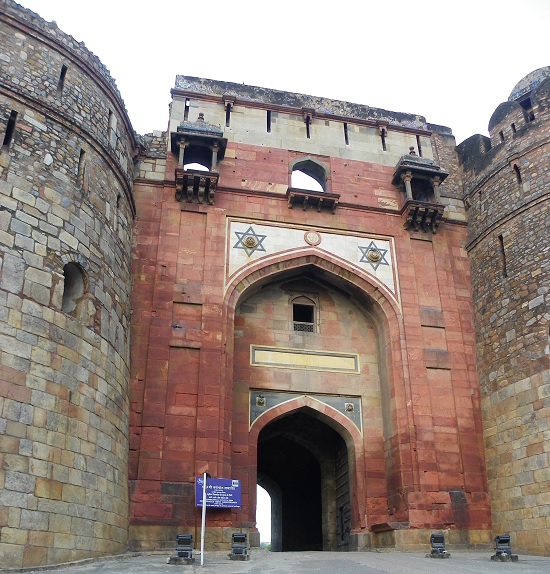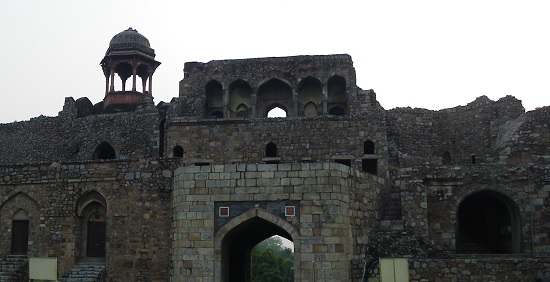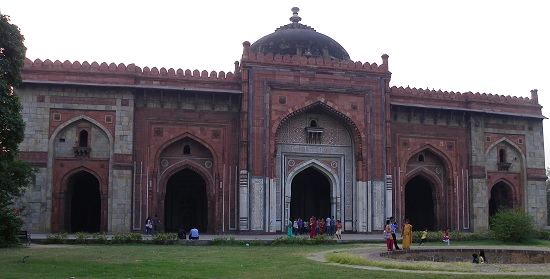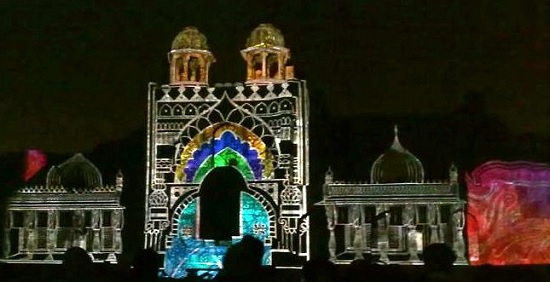Jan 05, 2026
Jan 05, 2026
by Sonam Gupta
Corroborating Source of Legendary Scores
Near khandava forest on the Yamuna was built a city with a wall as high as heaven and as white as silver and within mirrored lotuses began to grow in the ponds; people came to live in the city and songbirds came to live in the gardens and parks. [1]
The city being referred to here may not exist in the present day, might not have been seen by anyone alive but has been recorded and is talked of time and again. The city, on the banks of river Yamuna, the city of Indraprastha, as mentioned in one of the many versions of Hindu epic “Mahabharata”, its vivid description well past the imaginary and into the realm of the ‘surreal’ stirs intrigue.
As a matter of fact it is not only the city that is so astounding but also the palace within this city, ‘the palace of 1000 columns, buildings of white marble & pearl…lamps of softly shining gems in the room and hallways & arcades, floors adorned with fine carpets, the wide flight of stairs…the tree of lights with leaves of emerald and beryl ’.1
Digressing from the Kalyug Epic
Riveting as the description is, fascinating can be the knowledge that there is a good deal of circumstantial evidence that probably hints at Indraprastha being Delhi & the palace having stood where one of Delhi’s landmark monument stands today – “the old fort” or “Purana Qila”!

Though there is no direct evidence to establish the relation between the two but according to Cunningham, an eminent archaeologist and numismatist, the date of occupation of Indraprastha by Yudhishtra may be assigned to the 15th Century B.C. [3] without debating on the premise that made him conclude the same it might be worth noting that excavations at Purana Qila have yielded Painted Grey Ware (PGW) pottery dated to 1000 B.C.
Also, may be a sheer coincidence but nonetheless, the disinterring of similar remains at other sites associated with Mahabharata do nothing to alleviate the perplexity. Besides, the fact that till 1913 there was a village within the fort walls called Indraprat, adds credence to the theory that Purana Qila is built on the remains of Indraprastha.
Lauding the Acknowledged History
As we shift focus from the rather controvertible aspects of history associated with Purana Qila to the more indubitable and unanimously accepted factions, we might loose on what can be our living rendition of the LOTR, but the monument doesn’t lose its appeal. For this monument has been a witness to the savages of time, destructions and creations of a city after another. The fort that we see today with its magnificent walls that reach up to 18 meters in places, holes arranged in interesting patterns on the walls which were apparently meant to be nesting spaces for birds and are still thronged by hundreds of parrots and pigeons, was constructed bit by bit by some of the most opulent emperors and rulers.
In the year 1533, emperor Humayun, son of the first mughal, Babur, laid the foundations of a city he named Dinpanah, or the Refuge of the Faithful. The inner citadel of this city is today known as Purana Qila (Old Fort). Within six years, Humayun was ousted by Sher Shah Suri who promptly renamed the city Shergarh. Sher shah Suri destroyed Dinpanah and raised a citadel on the same site. The initial years of Humayun’s reign were strife with various issues and it is considered that even though the foundations of the city were laid, not much of architectural or any building activity took place during those years. As a matter of fact, there stands no extant building from those years; this may be attributed to the minimal construction that Humayun could undertake during his initial years or to the fact that Sher shah Suri after seizing the throne in around 1540 destroyed Humayun’s city to lay the foundations of his new city (Shergarh). It is believed that for around 15 years the then Delhi and this citadel saw a number of successors, governors and conquests, like Adil shah, Ibrahim khan and Hemu, to name a few, some famous and some infamous for the disaffection amongst populace. Eventually, though, Humayun, defeating all other forces, regained the throne of Delhi. And, as popularly believed, completed the Qila that Sher shah could not complete. But, his second stint, as is popularly held, was cut short owing to his demise by tripping from the steps of Sher Mandal.

One of the buildings inside the premises of the fort ‘Sher Mandal’, which in comparison with the other parts of the complex might not have caught general attention but in view of the culpability imposed on the building, it has become rather conspicuous.
Ruins and the Prima Facie
All said and done as the ruins of the fort stand today, it has a rather irregularly oblong plan, with bastions on the corners and in the western wall. Of all that once must have been, three gates can still be seen – Humayun darwaza, talaqi Darwaza (‘forbidden gate’) and the Bara Darwaza. The gateway used to enter the fort today is the Bara Darwaza and the gate to the south, the Humayun Darwaza, is called so not because it was built by Humayun but probably because Humayun’s Tomb is visible through it. Though there existed scribbling in ink in a recess at the Talaqi Darwaza, which according to archaeologist YD Sharma mentions of Humayun and hence it is inferred that this gate was probably constructed or at least repaired by Humayun.
Once inside the campus, other than the notoriously infamous Sher Mandal, there are a few more buildings still extant amongst those is the mosque – qala – I – kuhna masjid built by Sultan Sher Shah Suri. This mosque is considered to be the sultan’s finest architectural statements. The central portion of this mosque is done in white marble and the rest of it is beautifully contrasted by the use of deep red sandstone, though what led the builders to use sandstone is not known, scarcity of white marble is the general assumption having lead to the same. Whatever might have been the reason the contrast sure comes across as a pleasing building character.
The inner west wall of the masjid has five openings with horse shoe shaped arches that are richly ornamented in white and black marble. The central arch, higher than the other and framed within a projection, is flanked by narrow fluted pilasters. The recessed surface of the arch, through which there is an opening, is beautifully decorated with inlay of marble and other stones and contains a small oriel window at its apex. The two arches on either side also have similar treatment, but with lesser ornamentation. The mihrabs inside the prayer hall are exquisitely decorated with concentric arches providing further scope for ornamentation. The rear corners rise with double- storeyed towers and oriel windows. Stair – cases lead to a narrow gallery on the second storey from both the ends in the hall. The central bay of the hall accommodates a dome, with traces of chhatris on either side.

On a marble slab within the mosque is an inscription which translates as ‘as long as there are people on this earth, may this edifice be frequented and people be cheerful and happy in it’. Though, no one is seen offering prayers in this mosque any longer but then, the many visitors and tourists that throng the place add prominence to the translation. At the ground level, in the area that serves as the foreground to the mosque today can be seen the remnants of what was a tank once.
The Sher Mandal too is said to have been built by Sher shah. A two storeyed octagonal pavilion with recessed arches at the ground and first floor on each of its sides, it is done majorly in red sandstone and relieved by white marble. The central chamber of the second storey is cruciform with recesses on its four sides, while the dados of the interior are decorated with glazed tiles; the upper portion contains incised and painted plaster work. Sher shah Suri probably built it as a pleasure resort but Humayun, who tripped on its staircase in 1556, it is believed, used it as his library. It is probably owing to the story that the staircase has been tagged tortuous and gory and all the entrances to the pavilion have been shut, prohibiting people inside it.
Abutting Sher Mandal is the location of the excavation site from where were dug out the PGW, it is probably because the site has now been back-filled that it goes unnoticed with most of the people who visit the fort. On the west of Sher Mandal is the ‘hammam’ or the bath and to the south of the path leading to the masjid is a 22- meter deep baoli or step well, access to which has been cordoned off by dilapidated iron gates. But standing close to the old rusted gates one can see birds and pigeons flanking the structure right through the flight of stairs that lead to the apparent base of the step well.
Today as the fort stands, withered by time as witness to the many ups and downs the city has faced, it righteously hosts a digital tale of the city beautifully composed and compiled in the form of a light and sound show. The USP of this show is its background, the fort, which, under dim lighting has a renewed appeal besides, given the show is about the history of ‘Delhi’ and is titled ‘ishq-e-dilli’, what better venue could one have thought of than this site, which has seen many a kings, emperors and rulers wheedling into its charms with the intent of conquest come here, stay but in the long run only to be ousted by fate itself and in the end all that remains is the fort that over the ages has stayed to prove that it has always been invincible; be it to the mighty annexations or to my humble words.
The details of this show can be found at the Delhi tourism website and any visit to Delhi would be incomplete without a visit to the fort and the show, which captures the essence of Delhi’s history so effectively.

Photo credit – Pradeep Attri
Works Cited
Images by Author
15-Sep-2018
More by : Sonam Gupta